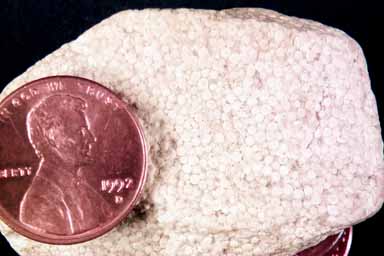|
OOLITIC LIMESTONE #1 Oosparite Go on to: #1 | #2 | #3 | #4  Detail of this specimen
Detail of this specimen
Return to: Alphabetical Listing Basic Key Carbonate Key |
||
|
Composition
Calcite - CaCO3, formed into small pearl-like spheres, constructed as concentric layers. This is a chemical rocks, precipitated from warm, supersaturated marine water.
|
Description
A pure oolitic limestone with spar cement. The oolites are white, rounded, and concentrically layered, in the sand sized range. In some of the broken oolites we can see the seed in the middle which began the oolite, and the concentric layers by which the oolite was built. In the unbroken examples the oolite just looks like a tiny pearl.
The spar cement is clear calcite precipitated between the oolites by ground water after deposition. It looks transparent or slightly gray, almost like a clear glue binding the oolites together.
|
|
|
Tectonic Association
Carbonates of all types are commonly associated with regions of tectonic stability and tropical climates, that is no mountain building, and stable, shallow water environments associated with continental shelves or epeiric (epicontinental) seas.Go to Carbonate Tectonics for more explanation. |
Formation & Environments
Oolites form today in warm, supersaturated, shallow, highly aggitated marine water. They are commonly associated with zones of high tidal activity in a subtidal or lower intertidal environment.The mechanism of formation is to begin with a seed of some sort, perhaps a shell fragment. The strong currents wash this seed around on the bottom where it accumulates a layer of chemically precipitated calcite from the supersaturated water. Only this process is going on with uncounted trillions of oolites. The oolites are commonly found in large dunes (megaripples); if you could be there you could scoop up the oolites in your arms and hands. The concentric layers is formed as the oolites are alternately exposed to pick up a concentric layer, and then buried to set the layer. The next exposure then adds another layer. |
|